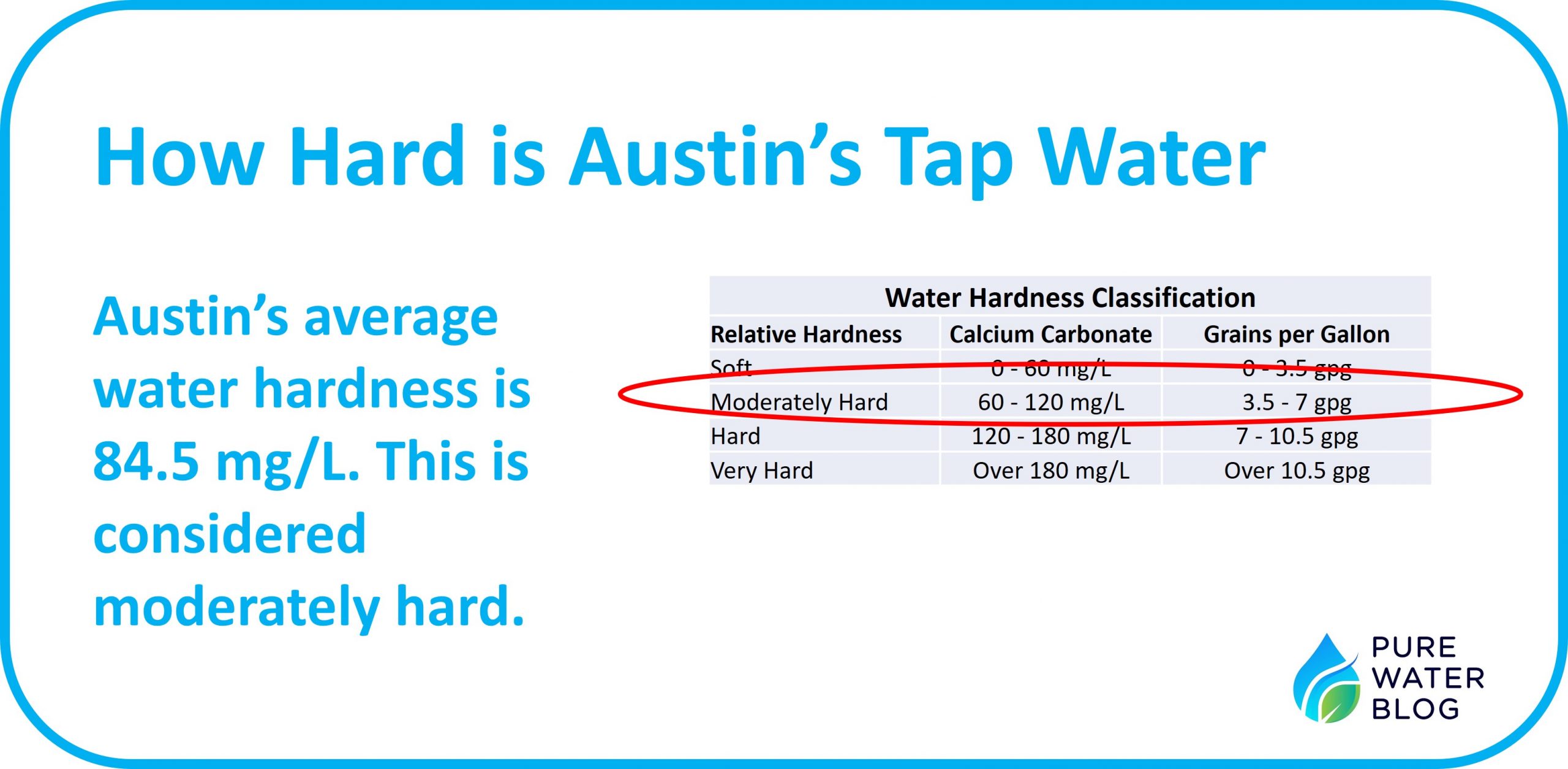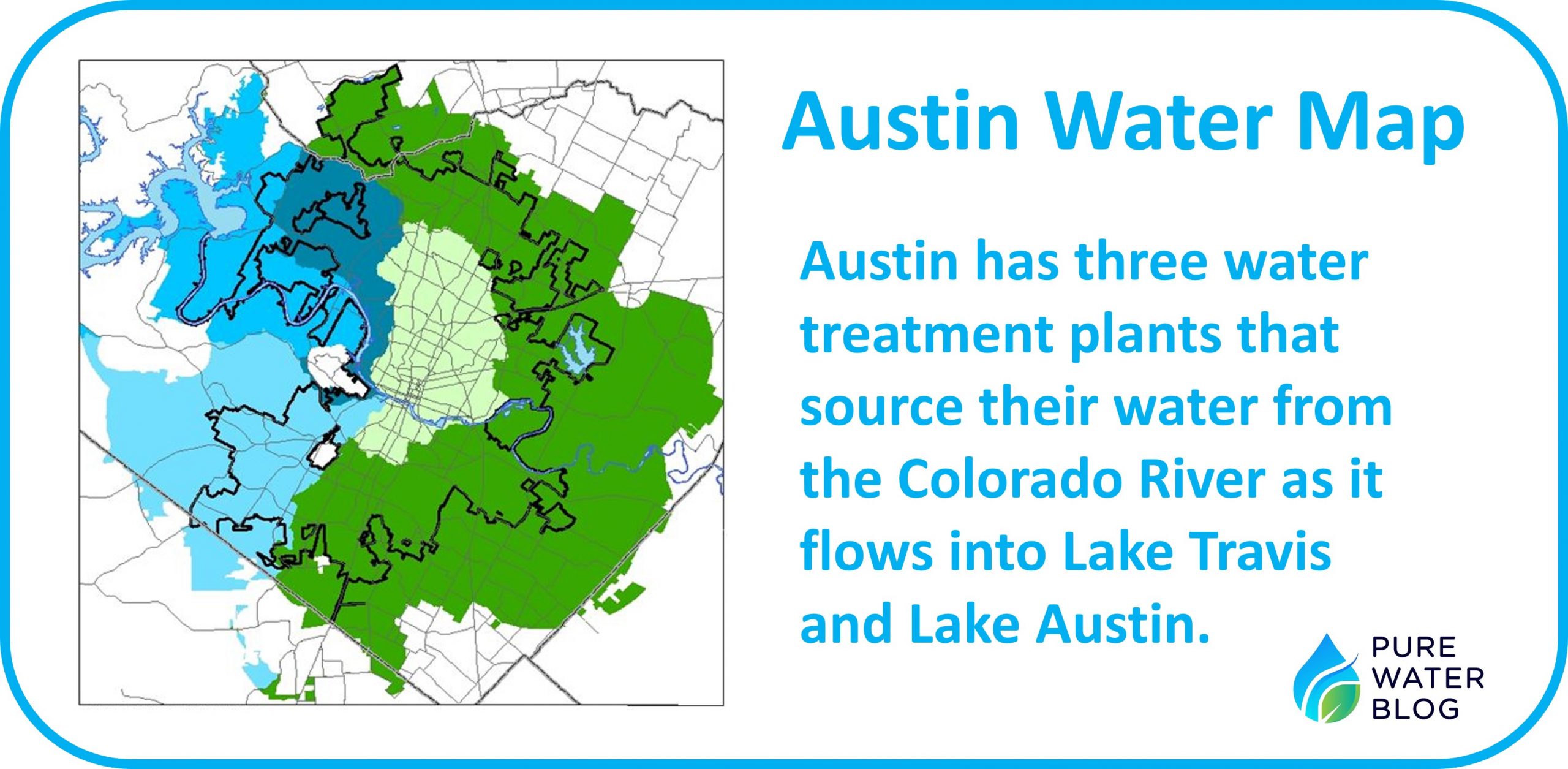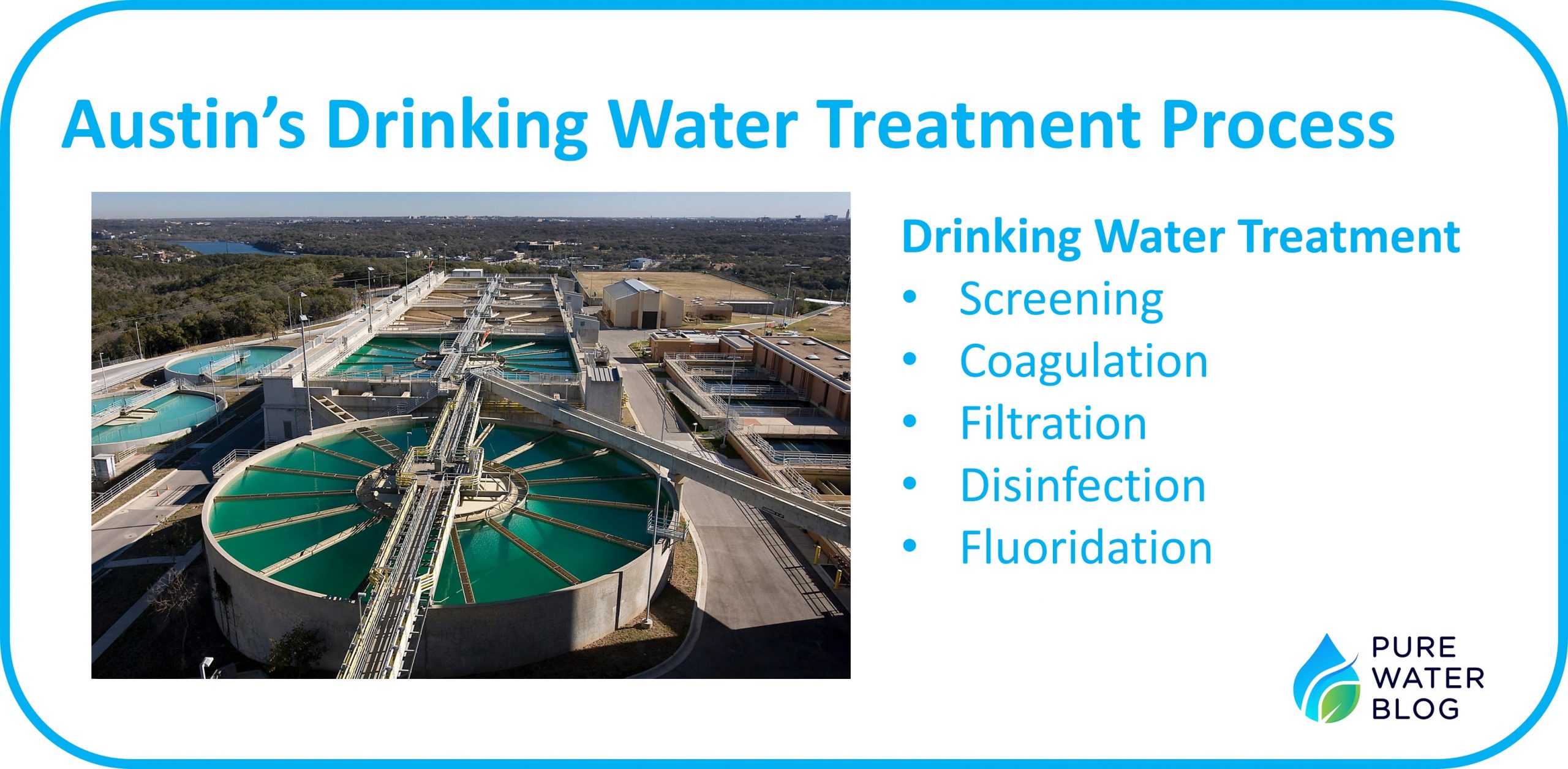Does Austin have hard water? This is a question that many homeowners in the Austin area have been asking themselves.
Austin water has a hardness of 84.5 ppm which is considered moderately hard. This means that the water contains slightly elevated levels of minerals like calcium and magnesium, which can cause issues such as soap scum, scale buildup, and dry skin. Most Austin residents don’t need a water softener because these levels of hardness can be managed by routinely cleaning your plumbing fixtures.
In this article, we will explore the topic of water hardness in Austin, Texas, how to soften hard water, and a lot more.
You may be interested in my article about water hardness in other cities.
Table of Contents
Does Austin Have Hard Water?

Austin’s water has a moderate level of hardness, which is lower than what is typically considered as “hard” water. According to the City of Austin Water Utility, the water has a hardness level of 84 milligrams per liter (mg/L) or 4.9 grains per gallon (gpg), which falls within the moderate range. The United States Geological Survey (USGS) defines water that falls between 60 and 120 ppm as moderately hard.
Although slightly hard water is not a major health concern, it can cause issues such as soap scum, scale buildup, and dry skin. The good news is that there are treatment options available to soften your water and improve its quality.
The table below summarizes the water hardness in Austin and the major cities and towns in Texas.
| City | Average Hardness Calcium Carbonate mg/L | Average Hardness Grains per Gallon |
| Austin | 84.5 | 5 |
| Abilene | 284 | 16.7 |
| Allen | 146.5 | 8.6 |
| Arlington | 89.3 | 5.3 |
| Bedford | 107 | 6.3 |
| Brownsville | 185.7 | 10.9 |
| Bryan | 8 | 0.5 |
| Burleson | 140 | 8.2 |
| Cedar Park | 181 | 10.6 |
| College Station | 7.9 | 0.5 |
| Corpus Christi | 227 | 13.3 |
| Euless | 57.7 | 3.4 |
| Fort Worth | 140 | 8.2 |
| Frisco | 146.5 | 8.6 |
| Galveston | 200 | 11.7 |
| Garland | 161.5 | 9.5 |
| Grand Prairie | 132 | 7.8 |
| Grapevine | 112 | 6.6 |
| Houston | 135 | 7.9 |
| Irving | 135 | 7.9 |
| Keller | 140 | 8.2 |
| Leander | 175 | 10.3 |
| Lewisville | 114.6 | 6.8 |
| Little Elm | 146.5 | 8.6 |
| Longview | 59.6 | 3.5 |
| Lubbock | 243 | 14.3 |
| Mansfield | 99.8 | 5.9 |
| Mesquite | 146.5 | 8.6 |
| Midland | 500 | 29.3 |
| New Braunfels | 266.5 | 15.6 |
| North Richland Hills | 134.5 | 7.9 |
| Pflugerville | 118 | 7 |
| Plano | 146.5 | 8.6 |
| Richardson | 146.5 | 8.6 |
| Round Rock | 187 | 11 |
| Rowlett | 146.5 | 8.6 |
| San Angelo | 288 | 16.9 |
| San Marcos | 260 | 15.3 |
| Sugar Land | 143 | 8.4 |
| Temple | 149 | 8.8 |
| Texas City | 200 | 11.7 |
| Victoria | 226 | 13.3 |
| Wylie | 146.5 | 8.6 |
Learn about water hardness in these cities:
Does San Francisco have hard water?
Does Dallas have hard water?
Texas Water Hardness
Texas is a large state that draws its drinking water from various sources, including surface water from lakes and rivers, and groundwater from aquifers. The state’s water hardness levels can vary depending on the source and location.
According to a report by the Texas Water Development Board, water hardness levels in Texas can range from less than 50 milligrams per liter (mg/L) to over 500 mg/L. Generally, areas in the eastern part of the state tend to have softer water, with hardness levels ranging from 50 to 150 mg/L. In contrast, areas in the western part of the state tend to have harder water, with some locations having hardness levels of over 300 mg/L.
What is Hard Water?
Hard water is a term used to describe water that contains elevated levels of dissolved minerals, such as calcium and magnesium. These minerals are naturally occurring in the earth’s crust and can seep into groundwater sources, which supply drinking water to many homes and communities.
When hard water is heated or evaporates, the minerals can form a buildup of mineral deposits, also known as scale, on the surfaces of pipes, appliances, and fixtures. This can cause issues such as reduced water flow, clogged pipes, and decreased appliance efficiency.
What are the problems caused by hard water?
In addition to mineral buildup, hard water can cause other problems in your home. For example, it can leave unsightly soap scum on bathroom surfaces and make it more difficult for soaps and shampoos to lather properly. Hard water can also cause dry and itchy skin, as well as make clothes appear dull and faded after washing.
Hard water can also affect the taste and quality of your drinking water. The minerals in hard water can give it a slightly bitter or metallic taste, which some people find unpleasant.
Who is Austin’s Water Provider?
Austin Water provides drinking water to residents of the City of Austin and surrounding areas. The utility draws water from the Colorado River as it flows into Lake Travis and Lake Austin.
Where does Austin Water Come From?

The City of Austin Water Utility draws its water from two main sources: the Colorado River and the Highland Lakes. The Colorado River is the primary source of drinking water for the City of Austin and is located approximately 200 miles west of the city.
The Highland Lakes, which include Lake Travis and Lake Buchanan, are located closer to Austin and are used as a secondary source of water. The lakes are also used for recreation, including boating, fishing, and swimming.
Is Austin’s Tap Water Treated?

Yes, Austin’s tap water is treated to ensure that it is safe to drink. The City of Austin Water Utility uses several treatment methods to remove impurities and disinfect the water supply. These methods include:
- Coagulation and Flocculation: This process involves adding chemicals to the water to help impurities clump together, making them easier to remove.
- Sedimentation: Once the impurities have clumped together, they settle to the bottom of the water supply.
- Filtration: The water is then filtered through layers of sand, gravel, and charcoal to remove any remaining impurities.
- Disinfection: To kill any remaining bacteria and viruses in the water, chlorine is added to the supply.
- pH Adjustment: The pH of the water is adjusted to help prevent corrosion in the distribution pipes and to make sure the water is not too acidic or basic.
- Fluoridation: Fluoride is added to the water supply to help prevent tooth decay.
Drinking water is treated at one of three treatment plants. These are:
- Berl L. Handcox Sr. Water Treatment Plant
- Albert R. Davis Water Treatment Plant
- Albert H. Ullrich Water Treatment Plant
Quality of Austin Tap Water
The City of Austin Water Utility regularly tests the tap water to ensure that it meets all state and federal quality standards. They also perform additional testing to monitor for potential contaminants.
According to the 2021 Water Quality Report, the water supply meets or exceeds all state and federal quality standards. The report indicates that the water supply is free of contaminants such as lead, copper, and bacteria, and that it is safe to drink.
Despite the high quality of the drinking water supply, some customers complain about the taste, smell, and appearance of the water. These characteristics are not harmful and are typically related to natural minerals and other substances found in the water.
How Much Water Does Austin Use Each Year?
The average daily water consumption in the Austin area was approximately 135 million gallons per day in 2020. This equates to an annual consumption of over 49 billion gallons of water.
Despite the high levels of water consumption, the City of Austin has implemented various water conservation efforts to ensure sustainable use of the water supply. These efforts include offering rebates for water-efficient appliances, providing free irrigation system evaluations, and offering educational resources to help customers conserve water.
Texas Water Use and Consumption in Statistics
Texas is the second-largest state in the United States, with a population of over 29 million people. The state is home to a vast network of rivers, lakes, and aquifers, which provide the primary source of drinking water for its residents.
According to the Texas Water Development Board, the state’s total water use was approximately 15.5 million acre-feet (5.1 trillion gallons) in 2019. Of this total, approximately 60 percent was used for irrigation, 27 percent for municipal use (including drinking water), and 13 percent for industrial use.
The top five Texas cities with the highest water consumption are:
- Houston
- San Antonio
- Dallas
- Fort Worth
- Austin
The City of Houston alone accounts for approximately 15 percent of the state’s total water use.
What Can I Do About Hardness in My Water?
If you have hard water in your home, there are several options available:
- Water Softener: A water softener is a device that removes minerals like calcium and magnesium from the water. It uses an ion exchange process to replace the minerals with sodium or potassium ions, which do not cause hardness. Water softeners are effective at reducing the negative effects of hard water on appliances, clothes, and skin.
- Reverse Osmosis System: A reverse osmosis system uses a semi-permeable membrane to filter out minerals and other contaminants from the water. This system can remove up to 95 percent of the minerals that cause hardness. However, it may not be the most practical solution for large households or high water usage.
- Chemical Treatment: Chemical treatments like chelating agents and sequestrants can be added to the water to bind to the minerals that cause hardness, preventing them from forming deposits. These treatments are typically added to the water as it enters the home and are effective at reducing buildup in pipes and appliances.
Final Take on Water Hardness in Austin, Texas
Hard water is a common issue in many areas, including Austin, Texas. While moderately hard water is generally safe to drink, it can cause problems with scaling, appliance damage, and skin irritation.
Thankfully, there are several effective solutions to address hardness in your water, such as using a water softener, a reverse osmosis system, or chemical treatments. By taking steps to address water hardness, you can improve the quality and safety of your drinking water and protect your appliances and plumbing from damage.

